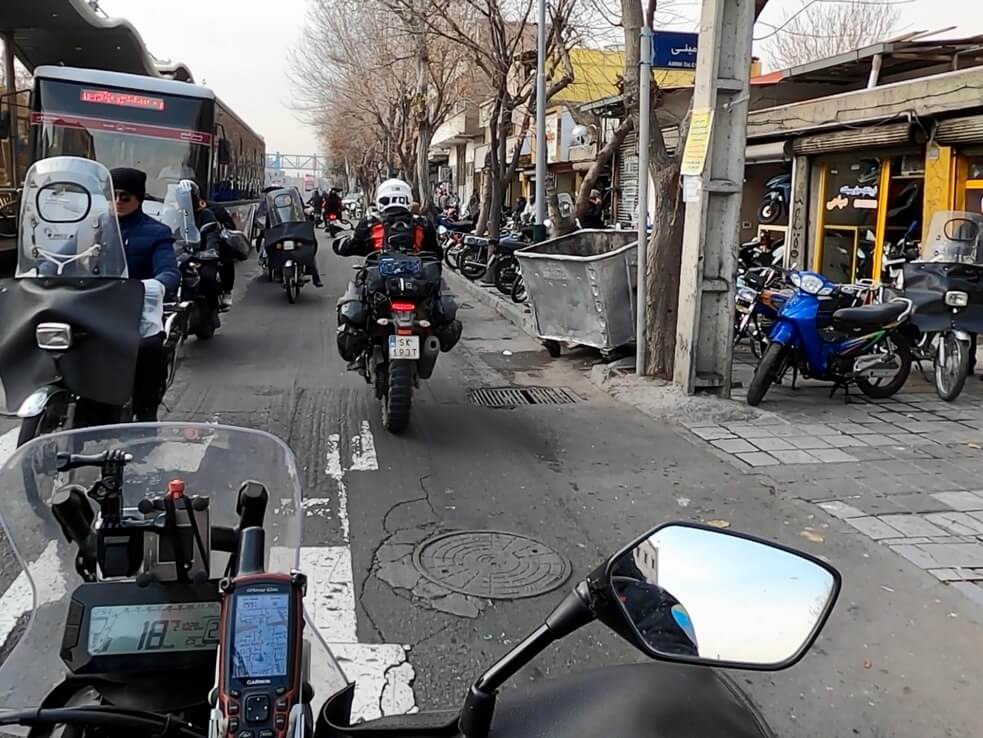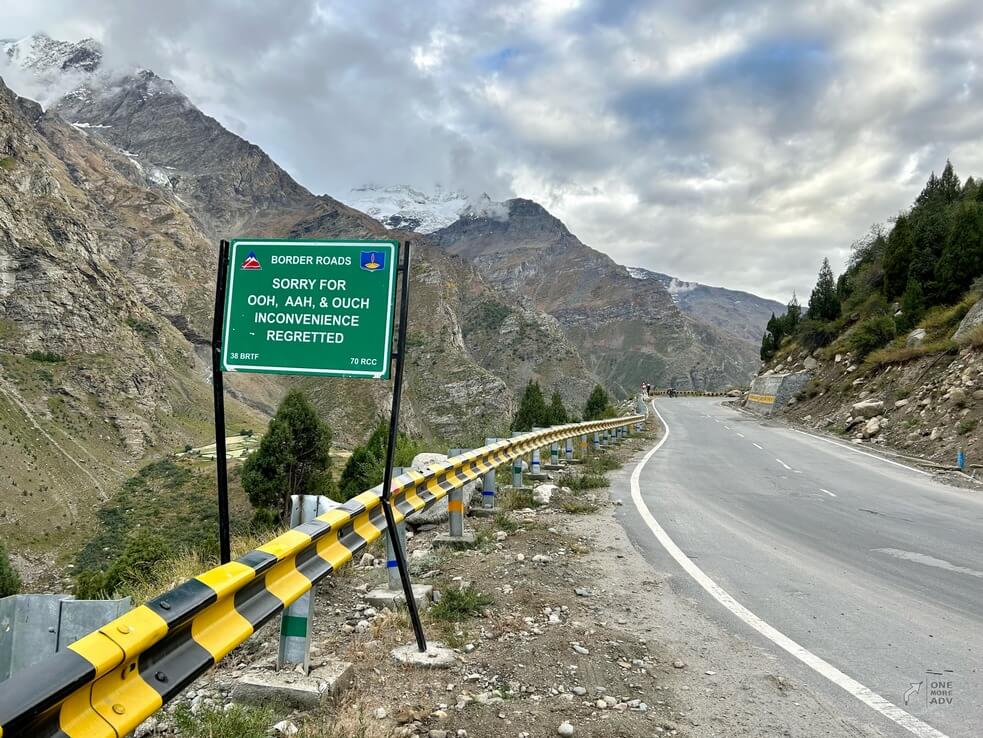What a ride!
We are out of town on expressway. Cruising speed 110-120 km/h.
A white Saipa has been driving next to me for a while. The woman, from the passenger seat, watches our duo closely, while the driver glances alternately at me and the road. I’m almost sure that the window will soon go down, and a smartphone lens aimed at me will flash in the window.
However, the car pulls up to Jacek’s level and keeps a steady pace. I bet with myself how long it will take before the curious lady allows herself to film the hareji – foreign tourists on big motorcycles.
The window opens and…. A sizable orange flies towards Jacek. Thrown energetically from the driver’s hands, it hit him quite painfully in the arm.
An act of road rage? No – a treat. Just Iranian hospitality.
When you go to Thailand, Sri Lanka, or India – to any single country – you familiarize yourself with the local road law regulations, with what the signs look like, you look for information on what to watch out for, how the locals actually drive and what you can be fined for.
And if you forgot to do that? Then you have to adapt on the go. Learn how we do it.
What we do right across the border
Western countries tend to help drivers by placing a board with the speed limit on different roads within the first few kilometers from the border. We always slow down at it and memorize how much we are allowed. The rest of the issues in the EU are simple. Road traffic is regulated by a similar logic – the smaller one always has priority – pedestrian, cyclist, at the end there is always a truck – it is the least allowed on the roads. Vehicles are in good technical condition, equipped with a complete set of lights and mirrors. There are a lot of signs and drivers in the vast majority strictly adhere to them.
The Balkan traffic becomes restless. The road signs are still there, but drivers seem to loosely adhere to the road law. The roads are in worse condition, there are fewer signs, and the vehicles…. hmmm there is more diversity. Here, speed is dictated by the capabilities of the vehicle and the condition of the road surface, not by some external legal regulations.

That’s why in the first few kilometers across the border we turn on the observation mode. Riding cautiously with eyes around our head. We find a vehicle that drives confidently and smoothly, and we pin ourselves to its trajectory. We model the driving style, keeping ourselves at an equal distance behind it. In the meantime, we observe what vehicles are there in road traffic and learn their typical maneuvers. We get to know the culture of road management – the presence of signs, the condition of the surface, traffic cops – all this affects the understanding of what local drivers are doing.
And what are they doing? You wouldn’t come up with it yourself, it’s simply amazing.
What do we pay attention to?
1. Vehicles on the road. What is the tribal composition of road traffic?
In Asia, different types of vehicles are like tribes – if one prevails, it dominates the others and usually moves the most smoothly. Customarily, it also has the most leeway – that is, it breaks the most rules, or … establishes its own “road laws”. In Vietnam, scooters rule, cars ineptly push themselves between them. In Iran – blue Zamyad pickups are the fastest and have the most aggressive driving style. The dominant tribe – that’s the one we carefully watch out for on the road.

The technical condition of the vehicles is also important. Motorcycles don’t have mirrors? That means they will drive under our wheels. It’s like on a ski slope – what matters is what’s in front, and the one behind has to watch out. Vehicles without lights during the day? They won’t have lights at night either. They may move very slowly and in the middle of the road.
2. Road signs
Are there white lines separating the lanes of traffic? If most of them are not there – drivers are not used to sticking to their lane. Expect driving in the middle of the road and constant cutting of corners. When the lines do appear – drivers ignore their existence and can suddenly turn across 3 lanes of road, not looking beforehand in the mirrors.

Are there vertical signs? Do we understand them? Sometimes the sign is in a known road convention, but the pictogram is as clear as an Egyptian hieroglyph. We decipher the meanings using the internet, or by asking drivers at gas stations.

Do warning signs correlate with road hazards? In the opinion of many drivers in Poland, speed limits and warnings of dangerous bends are often not adapted to the actual danger. However, the further east, the fewer signs and more dangers, so if they are – we take them seriously.
Are there unusual markings? A pile of stones, or a stack of branches in the middle of the road almost always means a deep hole in lane. A burning tire on the shoulder at night? A few meters further there is probably a broken truck.
3. Driver behavior
Kurdistan here and there, but drivers drive quite differently on the Turkish and Iranian side of the border. If someone cuts you off in Turkey, forcing you to slow down, you can be sure that he is just turning from the left lane to the right. If he does it in Iran – he just stared at you, because he never saw such a motorcycle and his car goes where the driver looks.
Behavior on the roads is like personality – it is the result of a whole set of life circumstances in a given country. The internal socio-political organization determines access to driving equipment and admission to traffic, the way of enforcing road regulations and law in general and a million other things, for which “it is what it is”. Competence resulting from a passed or bribed exam are the tip of the iceberg.
The further east, the more drivers hurry. However, in Turkey they simply “leak” consistently in their direction, while in Iran they “take their place” on the road for the sake of the future driving track, often blocking the passage of other, smaller vehicles.
That’s why observing driver behavior is the most important point for our safety. In addition, it is interesting, both for practical and ethnographic reasons.
In many countries, the use of turn signals is not popular. Intentions have to be read from the behavior of the vehicle. The driver drifts consistently to the left/right? He will turn. Another time you can forsee that he turns when he brakes sharply near the intersection. In Pakistan, when a vehicle makes room for you to overtake, it signals the opposite of what we do. We show that we will stick close to the shoulder, here the turn signal is lit from the axis of the road.
We always use blinkers – this makes our driving style – foreign here – to be much clearer and thus much safer for us.


Riding together – we do not keep a safe distance from each other in the European sense. We only keep it enough so that no car, rickshaw, or small motorcycle gets between us. Asian traffic does not tolerate vacuum, and every smallest space is immediately filled. If we split up, it will be harder for us to dodge, overtake and “leak” in our direction.
Can you understand this?
Yes. And like this “chaos”.
When you want to get a general picture of road traffic in Asia – you search on Youtube for “traffic in Vietnam” or “traffic in India”. You find videos of large intersections, where the free movement of vehicles reminds you of an anthill. You don’t see any rules, and you have the impression that riding there is veeeery dangerous. Unnecessarily. The speed in the cities is from a few to max 30-40 km/h, which in most cases allows for adequate reactions to the threats.
Besides, it’s like dancing, or soccer. It’s one thing to dance, play – another thing to watch from the stands. And the first one is much more enjoyable!







